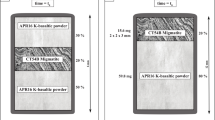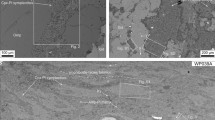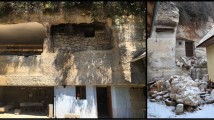Abstract
Step-scanning calorimetric measurements using a Setaram HT1500 calorimeter were performed between 800 and 1400°C on two natural samples: a ugandite from the East African rift and an olivine basalt from the western Mexican arc. Our measurements provide the first in-situ quantitative assessment of enthalpy during melting of initially crystalline natural samples. The distribution of latent heat across the liquidus-solidus intervals of the two samples is distinctly different, reflecting significant variation in the sequence and abundance of mineral phases during melting (clinopyroxene and leucite in the ugandite; olivine, clinopyroxene, and plagioclase in the basalt). Our data further indicate that the common assumption of a uniform distribution of latent heat across the liquidus-solidus interval of a magma is a reasonable approximation for the olivine basalt, but is grossly in error for the ugandite. This is due to cotectic precipitation of leucite and clinopyroxene, leading to a large, disproportionate release of latent heat early in the crystallization sequence. The implication for the thermal history of a crystallizing ugandite magma is that therate of heat loss during conductive cooling will unitially be more rapid than the average rate. The net result will be to produce lower magmatic temperatures after a given cooling interval relative to models assuming a uniform release of latent heat. An additional series of scanning calorimetric experiments were performed at variable rates (1,2 and 3°/min) to evaluate the role of kinetics on the distribution of enthalpy during both melting and crystallization of the ugandite and olivine basalt. The results indicate that clinopyroxene is the most important mineral phase in controlling the shapes of the enthalpy profiles during cooling; this is due to its large enthalpy of fusion and its tendency for sluggish nucleation, followed by rapid crystallization at temperatures that vary with cooling rate. The resolution of the calorimeter (in terms of heat detected per unit time) is also important in determining the shapes of theobserved enthalpy profiles during these rapid scans. Estimates based on the observed calorimetric signal associated with melting of olivine, and the lack of a calorimetric signal during melting of leucite, combined with known enthalpies of fusion for the two phases, indicate detection limits of approximately 0.6–1.2 kJ per 5 min increments.
Similar content being viewed by others
References
Berman RG (1988) Internally consistent thermodynamic data for minerals in the system K2O−Na2O−CaO−MgO−FeO−Fe2O3−Al2O3−SiO2−TiO2−H2O−CO2. J Petrol 29:445–522
Brandeis G, Jaupart C, Allegre CJ (1984) Nucleation, crystal growth and the thermal regime of cooling magmas. J Geophys Res 89:10,161–10,177
Brown, FH (1971) Volcanic petrology of the Toro-Ankole region, western Uganda. PhD thesis, University of California, Berkeley
Carslaw HS, Jaeger JC (1959) Conduction of heat in solids, 2nd edn. Oxford University Press, Oxford
Cashman KV (1993) Relationship between plagioclase crystallization and cooling rate in basaltic melts. Contrib Mineral Petrol 113:126–142
Delaney PT (1988) Portran 77 programs for conductive cooling of dikes with temperature-dependent thermal properties and heat of crystallization. Comp Geosci 14:181–212
DeYoreo JJ, Lux DR, Guidotti CV (1989) The role of crustal anatexis and magma migration in the thermal evolution of regions of thickened continental crust. In: Daly JS, Cliff RA, Yardley BWD (eds) Evolution of metamorphic belts. Geol Soc London Spec Publ 43:187–202
Ghiorso MS (1991) Temperatures in and around cooling magma bodies. In: Perchuk LL (ed) Progress in metamorphic and magmatic petrology. Cambridge University Press, Cambridge, pp 387–410
Ghiorso MS, Carmichael ISE (1987) Modeling magmatic systems: petrologic applications. In: Carmichael ISE, Eugster HP (eds) Thermodynamic modeling of geological materials (Reviews in Mineralogy, vol. 17). ch-pp 467–499
Ghiorso MS, Carmichael ISE, Rivers ML, Sack RO (1983) The Gibbs free energy of mixing of natural silicate liquids: an expanded regular solution approximation for the calculation of magmatic intensive variables. Contrib Mineral Petrol 84:107–145
Jaeger JC (1959) Temperatures outside a cooling intrusive sheet. Am J Sci 257:44–54
Jaeger JC (1961) The cooling of irregularly shaped igneous bodies. Am J Sci 259:721–734
Kelley KK (1960) Contributions to the data on theoretical metallurgy. XIII. High temperature heat content, heat capacity, and entropy data for the elements and inorganic compounds. US Bur Mines Bull 584
Kilinc A, Carmichael ISE, Rivers ML, Sack RO (1983) The ferricferrous ratio of natural silicate liquids equilibrated in air. Contrib Mineral Petrol 83:136–140
Lange RA, Navrotsky A (1992) Heat capacities of Fe2O3-bearing silicate liquids. Contrib Mineral Petrol 110:311–320
Lange RA, Carmichael ISE, Stebbins JF (1986) Phase transitions in leucite (KAlSi2O6), orthorhombic KAlSiO4, and their iron analogues (KFeSi2O6, KFeSiO4). Am Mineral 71:937–945
Lange RA, DeYoreo JJ, Navrotsky A (1991) Scanning calorimetric measurement of heat capacity during incongruent melting of diopside. Am Mineral 76:904–912
Larsen ES (1945) Time required for the crystallization of the great batholith of southern and lower California. Am J Sci 243A:399–416
Lovering TS (1936) Heat conduction in dissimilar rocks and the use of thermal models. Geol Soc Am Bull 47:87–100
Richet P, Bottinga Y (1984) Anorthite, andesine, wollastonite, diopside, cordierite and pyrope: thermodynamics of melting, glass transitions, and properties of the amorphous phases. Earth Planet Sci Lett 67:415–432
Richet P, Leclere F, Benoist L (1993) Melting of forsterite and spinel with implications for the glass transition of Mg2SiO4 liquid. Geophys Res Lett 20:1675–1678
Robie RA, Hemingway BS, Fisher JR (1978) Thermodynamic properties of minerals and related substances at 298.15 K and 1 bar (105 pascals) pressure and at high temperatures. US Geol Surv Bull 1452
Spohn T, Hort M, Fisher H (1988) Numerical simulation of the crystallization of multicomponent melts in thin dikes or sills 1. The liquidus phase. J Geophys Res 93:4880–4894
Stebbins JF, Carmichael ISE (1984) The heat of fussion of fayalite. Am Mineral 69:292–297
Stebbins JF, Carmichael ISE, Weill DE (1983) The high temperature liquid and glass heat contents and the heats of fusion of diopside, albite, sanidine and nepheline. Am Mineral 68:717–730
Wickham SM (1987) The segregation and emplacement of granitic magmas. J Geol Soc Lond 144:281–297
Wyllie PJ (1977) Crustal anatexis: an experimetal review. Tectonophysics 43:41–71
Author information
Authors and Affiliations
Rights and permissions
About this article
Cite this article
Lange, R.A., Cashman, K.V. & Navrotsky, A. Direct measurements of latent heat during crystallization and melting of a ugandite and an olivine basalt. Contr. Mineral. and Petrol. 118, 169–181 (1994). https://doi.org/10.1007/BF01052867
Received:
Accepted:
Issue Date:
DOI: https://doi.org/10.1007/BF01052867




